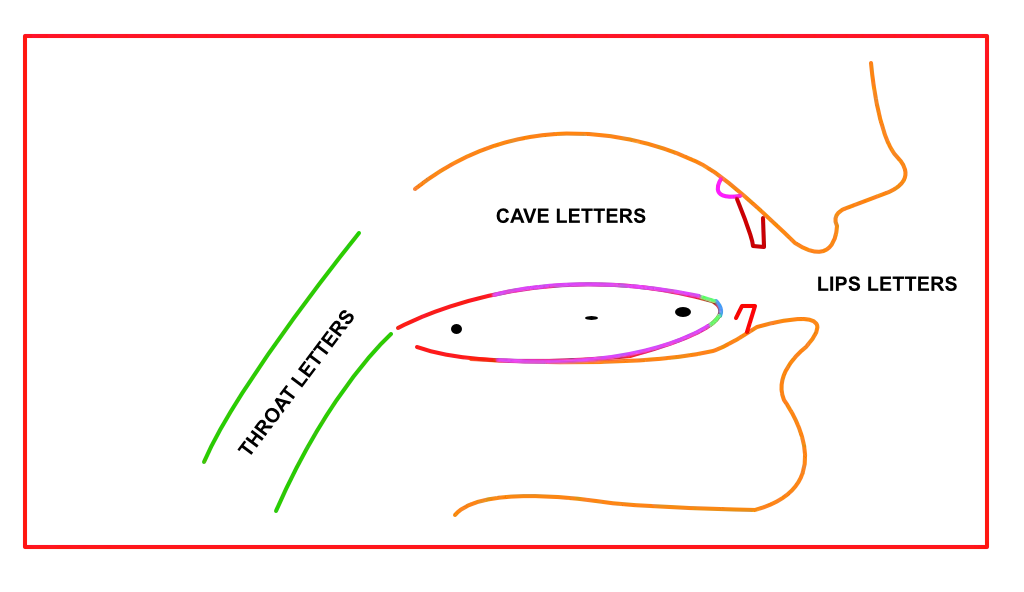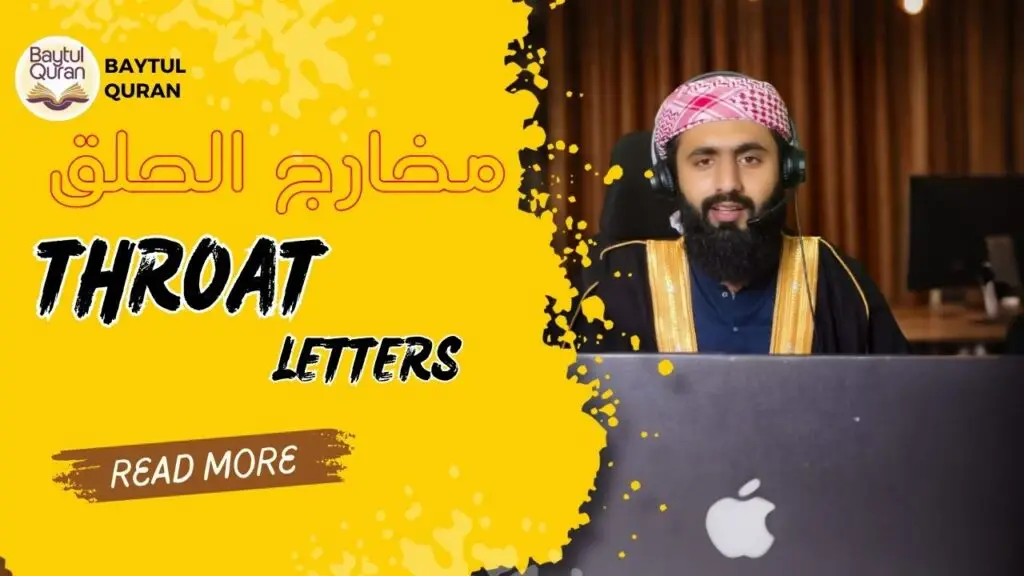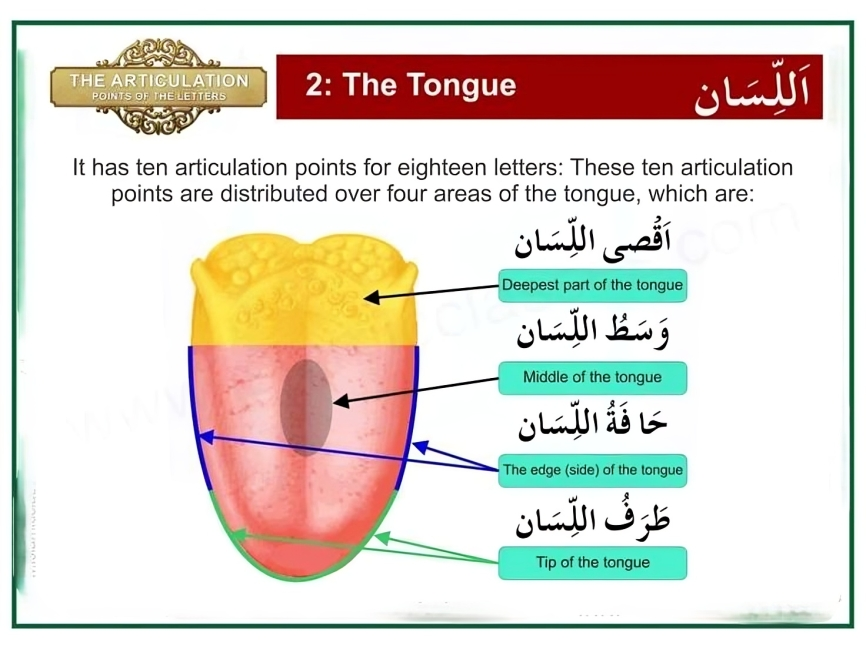By Baytul Quran
When we speak of the miraculous eloquence of the Qur’an, we must acknowledge the delicate science behind its pronunciation — Tajweed. Every letter of the Arabic language has a specific articulation point (مخرج), and knowing where a letter is pronounced from is the first step in honoring the words of Allah ﷻ. Today, we begin our journey into the Makharij al-Huruf (Articulation Points of Letters) by focusing on a special category known as Huruf al-Halq (Throat Letters).

📍 What Are Throat Letters? (حروف الحلق)
Huruf al-Halq are six Arabic letters that are pronounced exclusively from the throat (الحلق). The word Halq means “throat,” and these letters are uniquely formed without involving the tongue, lips, or nasal cavity.
The 6 throat letters are:
ء (Hamzah), هـ (Haa), ع (Ayn), ح (Haa), غ (Ghayn), خ (Khaa)
These are further divided into three categories based on their location in the throat — lower, middle, and upper. Let’s understand each group with precise explanation, real Quranic examples, and practical pronunciation tips.
🔽 1. Lower Throat – أدنى الحلق (Deepest part)
Letters: ء (Hamzah), هـ (Haa)
These letters emerge from the lowest part of the throat, closest to the chest area.
ء (Hamzah):
This letter is similar to a glottal stop in English — like the break between “uh-oh.”
It is always pronounced with a sudden, sharp burst of air.
Hamzah can carry any vowel (Zabar, Zer, Pesh), and though it originates from the throat, the sound resonates from the mouth depending on the vowel.
📘 Example:
إِنَّا أَعْطَيْنَاكَ الْكَوْثَرَ (Surah Al-Kawthar, 108:1)
“Indeed, We have granted you Al-Kawthar.”
The ء in أعطيناك is clearly audible from the lower throat with a burst.
هـ (Haa):
A breathy, soft letter — similar to the English “h” but much lighter and comes directly from the throat.
📘 Example:
قُلْ هُوَ اللَّهُ أَحَدٌ (Surah Al-Ikhlas, 112:1)
The هـ in هوَ must be pronounced softly from the lowest throat.
🔍 Common Mistake:
Confusing هـ with the heavy خ or ح. هـ is breathy and should not have a rough sound.
🔘 2. Middle Throat – وسط الحلق (Middle part)
Letters: ع (Ayn), ح (Haa)
These letters emerge from the central part of the throat and are among the most difficult for non-Arab speakers.
ع (Ayn):
A voiced, deep sound. No exact English equivalent exists. It has a full, vibrating tone.
📘 Example:
غَيْرِ الْمَغْضُوبِ عَلَيْهِمْ وَلَا الضَّالِّينَ (Surah Al-Fatiha, 1:7)
The ع in عليهم comes from the middle throat, not the nose or chest.
🧠 Pronunciation Tip:
Try saying “aaa” from your throat while tightening the throat muscles to produce the right sound.
ح (Haa):
A strong but voiceless letter — almost like an intense whisper. It’s deeper and softer than خ but not silent.
📘 Example:
وَصَاحِبِهِمَا فِي الدُّنْيَا مَعْرُوفًا (Surah Luqman, 31:15)
The ح appears in words like صاحب, where it must be airy and from the mid-throat.
🔼 3. Upper Throat – أعلى الحلق (Top part)
Letters: غ (Ghayn), خ (Khaa)
These are pronounced from the upper throat, closest to the mouth and tonsils.
غ (Ghayn):
A voiced sound with vibration. It resembles the French “r” in Paris. It should have depth (تفخيم) in sound.
📘 Example:
غَيْرِ الْمَغْضُوبِ عَلَيْهِمْ (Surah Al-Fatiha, 1:7)
The غ must be recited with heaviness, not like the light ج.
خ (Khaa):
An unvoiced, raspy letter — like softly clearing your throat.
📘 Example:
خَلَقَ الْإِنسَانَ (Surah Al-Rahman, 55:3)
The خ in خلق is dry and scratchy, emerging from the upper throat.
🧠 Tip:
Don’t overdo it. The خ should be clear but not aggressive or overused like in some Urdu dialects.
✅ Comparison Chart:
| Throat Section | Letters | Characteristics | Example Words |
|---|---|---|---|
| Lower Throat (أدنى) | ء, هـ | Sharp (ء), airy (هـ) | أَحَدٌ, هُوَ |
| Middle Throat (وسط) | ع, ح | Deep & voiced (ع), breathy & soft (ح) | عَلَيْهِم, صَاحِبِهِ |
| Upper Throat (أعلى) | غ, خ | Heavy & vibrating (غ), raspy & dry (خ) | غَيْرِ, خَلَقَ |
🧾 Importance of Correct Pronunciation
Mispronouncing these throat letters can lead to:
- Changing the meaning of the word
- Losing the beauty and rhythm of Quranic recitation
- Disrespecting the precise message of Allah ﷻ
That’s why every student of the Qur’an must master these six letters before moving to advanced Tajweed concepts.
🎯 Practice Tips
- Recite slowly in front of a mirror.
- Listen and repeat after expert Qaris (like Qari Muhammad Abdullah and others).
- Record yourself and compare with professional recitation.
- Join a live Tajweed course from Baytul Quran for proper correction.
💡 Spiritual Reflection
Allah ﷻ revealed the Qur’an in the most perfect language — Arabic — and in the most precise articulation. Honoring its letters by learning their correct pronunciation is not just a linguistic duty, it is a spiritual obligation.
“And recite the Qur’an with measured recitation.”
وَرَتِّلِ الْقُرْآنَ تَرْتِيلًا (Surah Al-Muzzammil, 73:4)
Let us beautify our voices and hearts with the Book of Allah.
📢 Learn Tajweed with Baytul Quran
Join our structured online Tajweed courses, designed for both kids and adults, led by certified teachers with Ijazah. Take the next step in your Quranic journey.
🌐 Visit our website
📧 Email: info@baytulquran.com
📱 WhatsApp: +92 300 8737779 | +44 7842 064721
📺 YouTube: Baytul Quran
📸 Instagram: @baytulquran_1





